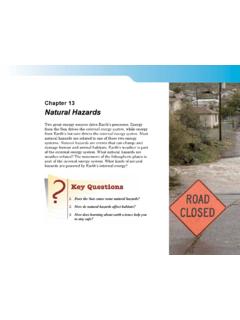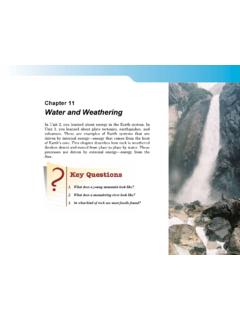Transcription of Chapter 6 Earth’s Surface and Heat
1 Chapter 6 earth s Surface and HeatHow does earth stay warm in cold, empty space? Most ofEarth s heat energy comes from the Sun by the process ofradiation. Energy from the Sun enters earth s atmosphereand some gets trapped. This trapped energy warms theplanet. In this Chapter you will learn that ocean currents,wind, and weather are all related to heat energy at earth Why is earth s atmosphere important?2. Why do palm trees grow in Scotland? 3. What causes wind?114 UNIT 2 ENERGY IN earth S SYSTEMSF igure : The Surface temperatures for planets in our solar temperature ( C)Mercury-170 to 390 Venus450 to 480 earth -88 to 48 Mars-89 to -31 Jupiter-108 Saturn-139 Uranus-197 Neptune-201 Pluto-223 How to read diagramsHow do you read a diagram?(1) Study the diagram to determine what information it is showing you.(2) Read the caption and title.(3) Question: Refer to the diagram at the left.
2 In your estimation, what was the most common land Surface temperature for July 2003? earth Is Just RightEarth is just right because its temperature is not too hot or too cold (Figure ). Metals like lead melt on the hot Surface of Venus, but not on earth . Some gases freeze solid on Pluto, but not on earth . earth s temperature is especially nurturing for living things. This section is about how earth s temperature stays just right. TemperatureWater for lifeThe temperature range on earth s Surface is just right for water to be a liquid. Liquid water is extremely important for living things. For example, an adult human body is 60% to 75% water. You need water to keep your blood, brain, and lungs working properly! earth stemperaturerangeEarth s Surface temperature stays within a narrow range it is not too hot or too cold. The average temperature of earth s Surface is about 15 C. This temperature is maintained because earth has an atmosphere which traps some of the Sun s energy.
3 Without an atmosphere, earth s Surface temperature would be about -18 earth IS JUST RIGHTCHAPTER 6: earth S Surface AND HEATE nergy and motionThe Sun s energyAlmost all of the heat energy on earth s Surface comes from the Sun. Hot spots like volcanoes and hot springs add some heat , but not as much as the Sun. At the same time that the Sun adds heat to earth 's Surface , heat is being lost to space. The balance between the Sun's heat and heat lost into space is what determines earth 's Surface s motionThe motion of earth also helps to balance its Surface temperature. Read on to find out how two of these motions, rotation and revolution, affect the temperature of every place on is the turning motion of a planet as it spins. It takes one day for earth to make one complete spin. For half of a day, your side of earth faces the Sun and experiences daytime. For the other half of the day, your side of earth faces away from the Sun and experiences nighttime.
4 The trick of spinning a basketball on your finger is a good example of rotation (Figure ).RevolutionRevolution is the motion of a planet around its star, like a race car that moves around and around a circular track (Figure ). One complete trip around the track would be one revolution. It takes about days for earth to make one revolution or one trip around the Sun. Later in this Chapter we ll learn how the revolution of earth is related to the : earth rotates on its axis and revolves around the - the motion of earth spinning on its axis; one rotation is called a - the motion of earth moving around the Sun; one revolution is called a 2 ENERGY IN earth S SYSTEMSG reenhouse GasesA greenhouse is a glass building where plants can be grown in a warm, moist environment. Scientists use the term greenhouse gases to describe certain gases in earth s atmosphere. Like the glass in a greenhouse, greenhouse gases can slow down earth s natural heat -loss processes.
5 These gases are useful because they keep earth warm. However, the amount of these gases is increasing in our atmosphere. Due to the increase, less heat energy will be able to leave earth . Scientists are concerned that the resulting rise in earth s average Surface temperature might alter climates and other aspects of our and earth s rotationMercury is toohot and too cold!It may seem strange to compare a planet to a grilled burger, but what happens if you put a burger on a hot grill and forget to turn it? The bottom will be burned to a crisp, and the top will be undercooked. The planet Mercury is like that. One day on Mercury lasts for about 58 earth days! The long day causes the temperature on the Sun-facing side of Mercury to reach about 400 C. Something made out of the metal lead would melt at this temperature! At the same time, the dark nighttime side plunges to -170 Celsius. That s so cold that the liquid in a thermometer would earth is justright not too hotor too cold!
6 Even though earth is farther away from the Sun than Mercury, our night side never gets as cold as Mercury s night side. Why not? Think about burgers again. A good chef turns the burger so it browns nicely on both sides. Similarly, the earth turns rapidly enough so that there isn t enough time for our night temperature to sink too low. In the same way, there isn t enough time for earth s day temperature to rise extremely earth IS JUST RIGHTCHAPTER 6: earth S Surface AND HEATR evolution and earth s seasonsWhy does Earthhave seasons?The diagram below shows earth at four different places in its revolution around the Sun. Why is it warmer in summer and cooler in winter in the northern hemisphere? In other words, why do seasons occur? earth is tiltedOne guess might be that earth is closer to the Sun during summer. But this isn t the correct answer! earth has seasons because it is tilted on its axis. During our summer, the northern hemisphere receives sunlight that is more direct than it is in the winter, and in summer there are more hours of daylight.
7 This means we have warmer temperatures in summer than we do in s axisEarth rotates about an imaginary axis that goes through its center. This axis is drawn on earth images in the diagram at the left. The diagram shows that earth is tilted at as it revolves around the axis connects the north and south poles. The north end of the axis points toward the North Star throughout the your own sketch of the diagram at the left. Based on today s date, indicate on your diagram where earth is on its path around the 2 ENERGY IN earth S SYSTEMSW ater is everywhere! 1. Look indoors and outdoors and list everything you see that contains water. Remember to include food, drinks, things in nature, and even YOU! 2. Make a second list of every activity, job, or process you do throughout a usual day where water is used. Compare your journal lists with your classmates. Are your lists complete? Why is January a winter month in the northern hemisphere but a summer month in the southern hemisphere?
8 Section Review1. Describe two way that make earth s climate just right for life on What is the source of most of earth s heat energy?3. Some of earth s heat energy is lost to space. Why is this important?4. Define the term rotation. How long is one rotation of earth ?5. Define the term revolution. How long is one revolution of earth around the Sun?6. earth s Surface does not get too hot or too cold compared to Mercury s Surface . What difference between the two planets makes this possible?7. What role do greenhouse gases play in keeping earth warm?8. Why does earth have seasons?9. Refer to the diagram on the previous page. During winter in the northern hemisphere, is the southern hemisphere tilted toward or away from the Sun?10. How many degrees is earth s axis tilted?11. There are more hours of sunlight and more direct sunlight during summer. How does winter compare to summer in terms of hours of sunlight?
9 12. Research: You will need to do research on the Internet or at the library to answer these What are the main greenhouse gases?b. Where do these gases come from?c. Which planet Venus or earth exhibits a stronger greenhouse effect? Why? OCEAN CURRENTSCHAPTER 6: earth S Surface AND Ocean CurrentsCooks sometimes wrap warm food in a piece of aluminum foil to keep it warm. Aluminum foil helps spread the heat energy around the food. Our atmosphere and oceans act like foil because they spread heat around our planet. In this section, you will learn how heat is spread around by ocean coversmost of earth ssurfaceOceans are massive bodies of seawater that cover much of earth s Surface . Land only covers about one-quarter of earth s Surface . The rest is covered with water, especially ocean water. About 97% of earth s water is contained in spreadheat energyIf earth was the same temperature everywhere, the winds and ocean currents would be very weak.
10 In Chapter 4 you learned that heat could spread from one place to another as a moving group of warm atoms. Oceans spread heat too. Oceans spread enormous amounts of energy from the hot equator toward the cold north and south poles. earth has five major oceans (Figure ). Can you name them? One of them was just named in the year 2000!Figure : earth s five major oceans. The Southern Ocean was recently named as a separate ocean in 2000 by the International Hydrographic Organization (IHO). The IHO includes representatives from 68 countries that border the world s 2 ENERGY IN earth S SYSTEMSF igure : The Gulf Stream is a Surface ocean : The equator is an imaginary line that forms a circle around earth , dividing it into the northern and southern ocean currents - wind-driven currents that move at the ocean Surface , often for very long causes Surface ocean currents?Wind createscurrentsEnergy from the Sun creates permanent belts of wind that blow over large parts of earth .








